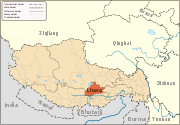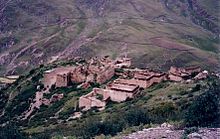- Yerpa
-
Yerpa
Monastery ruins, 1993Tibetan name Tibetan གཡེར་པ Wylie transliteration g•yer pa pronunciation in IPA [[jeːpa]] official transcription (PRC) Yêrba THDL Yerpa other transcriptions Yerpa Chinese name traditional 葉巴 simplified 叶巴 Pinyin Yèbā Coordinates: 29°44.87′N 91°16.83′E / 29.74783°N 91.2805°ECoordinates: 29°44.87′N 91°16.83′E / 29.74783°N 91.2805°E Monastery information Location Yerpa Valley, Lhasa Prefecture, Tibet, China Founded by Songtsen Gampo and Trisong Detsen Founded 7th-8th century Type Tibetan Buddhist Yerpa, also known as: Brag Yer-pa, Drak Yerpa, Druk Yerpa, Dagyeba, Dayerpa, and Trayerpa, is only a short drive to the east of Lhasa, and consists of a monastery and a number of ancient meditation caves that used to house about 300 monks.[1]
Contents
Description
The entrance to the Yerpa Valley is about 16 km northeast of Lhasa on the northern bank of the Kyichu. From there, it is another 10 km to the famous ancient meditation caves in the spectacular limestone cliffs of the Yerpa Valley. Tibetan: བྲག་ཡེར་པ་, Wylie: Brag Yer-pa
History
There are a number of small temples shrines and hermitages and the cliffs contain some of the earliest known meditation sites in Tibet, some dating back to pre-Buddhist times. Among the more famous are those traditionally connected with Songtsen Gampo (604–650 CE), (traditionally the 33rd king of the Yarlung Dynasty and first emperor of a united Tibet). His Tibetan queen, Monza Triucham, founded the Dra Yerpa temple here.[2]
He and his two foreign-born queens are said to have meditated in the 'Peu Marsergyi Temple' and in the 'Chogyel Puk', and to have discovered 'self-originated' symbols of the Buddha-body, speech and mind. Padmasambhava, or Guru Rinpoche (late 8th to early 9th century), meditated and practiced tantric yoga with his yogini Yeshe Tsogyal here, and to have spent 7 months in meditation in the 'Dawa Puk', which is considered to be one of his three most important places of attainment.[3]
After this, Yerpa became one of the three most important centres of meditation and retreat in Central Tibet. Several of Guru Rinpoche's disciples are also said to have meditated here. Atisha (982 - 1054 CE) preached extensively in the valley.[4] Atisha's hermitage is in ruins but had 300 monks in the 19th century and was the summer quarters for the Ramoche Monastery (the Upper Tantric College).[3]
Later histories record that both Songtsen Gampo and Trisong Detsen (756-797) founded temples at Yerpa, and Klu-mes Tshul-khrims did some refurbishing in the 11th century.[5][6]
Part of a series on Tibetan Buddhism
History Timeline · Related-topics Schools Nyingma · Kagyu · Sakya · Gelug · Bön · Jonang Key concepts Three marks of existence · Skandha · Cosmology · Saṃsāra · Rebirth · Bodhisattva · Dharma · Dependent origination · Karma Major figures Gautama Buddha · Padmasambhava · Je Tsongkhapa · Dalai Lama · Panchen Lama · Lama · Karmapa Lama · Rinpoche · Geshe · Terton · Tulku Buddhahood · Avalokiteśvara · Four stages of enlightenment · Tantric yoga · Paramitas · Meditation · Laity Changzhug · Drepung · Dzogchen · Ganden · Jokhang · Kumbum · Labrang · Mindroling · Namgyal · Narthang · Nechung · Pabonka · Palcho · Ralung · Ramoche · Sakya · Sanga · Sera · Shalu · Tashilhunpo · Tsurphu · Yerpa Chotrul Duchen · Dajyur · Losar · Monlam · Sho Dun Texts Kangyur · Tengyur · Tibetan canon · Mahayana sutras · Nyingma Gyubum Sand mandala · Thangka · Ashtamangala · Tree of physiology Outline · Comparative studies · Culture · List of topics · Portal
Tradition says that after Songtsen Gampo's only son, Gungri Gungsten, was born to Mangza Tricham, Princess of Mang, one of his wives: "A shrine and a stupa dedicated to the tutelary deity of mother and son were built upon the lap of a rocky mountain that resembled a seated image of the Holy Tara in the region of Yerpa."[7]
The famous legendary hero Gesar of Ling is said to have visited the valley. The holes his arrows left in the cliffs are believed to be evidence of his presence.
The ancient Kadampa gompa (Yerpa Drubde) passed to the Gelukpa control after Tsongkapa's reformation. There were some 300 monks living here from at least the beginning of the 19th century until 1959. It also acted as summer residence for the Gyuto Lhasa Tantric College.[8] The gompa was destroyed and the caves ransacked during the cultural revolution but there has been some rebuilding; new statues have been made and images repainted in the caves.
After Lhalung Pelgyi Dorje assassinated the anti-Buddhist Bon Emperor Langdarma in 842 CE, he is said to have hidden himself in a cave and meditated for 22 years, and his hat was kept there until 1959.[1][9][10]
There is an ancient sky burial site opposite the main caves.
-
A statue of Emperor Songtsän Gampo in his meditation cave at Yerpa
Footnotes
References
- Ancient Tibet: Research Materials from The Yeshe De Project (1986). Dharma Publishing. ISBN 0-89800-146-3.
- De Rossi Filibeck, Elena: "Names of known and less known places in Yer pa". In: Louis Ligeti (editor): Tibetan and Buddhist Studies Commemorating the 200th Anniversary of the Birth of Alexander Csoma de Körös. Vol. 2, Akadémiai Kiadó, Budapest 1984, ISBN 963 05 3903 9, p. 237-247.
- Dorje, Gyurme. 1999. Footprint Tibet Handbook. 2nd Edition. Bath, England. ISBN 1 900949 33 4. Also published by NTC Publishing Group, Lincolnwood, Illinois, U.S.A. in 1999. ISBN 978-0844221908; ISBN 0 8442-2190-2.
- Dowman, Keith. The Power-places of Central Tibet: The Pilgrim's Guide, pp. 73–79. 1988. Routledge & Kegan Paul. London. ISBN 0-7102-1370-0
- Gyaltsen, Sakyapa Sonam. The Clear Mirror: A Traditional Account of Tibet's Golden Age. Translated by McComas Taylor and Lama Choedak Yuthok. 1996. Snow Lion Publications, Ithaca, N.Y. ISBN 1-55939-048-4.
- Osada et al. (2000). Mapping the Tibetan World. Yukiyasu Osada, Gavin Allwright, and Atsushi Kanamaru. Reprint: 2004. Kotan Publishing, Tokyo. ISBN 0-9701716-0-9.
- Richardson, H. E. 1985. A Corpus of Early Tibetan Inscriptions. Royal Asiatic Society. ISBN 0-94759300-4.
Lhünzhub · Damxung · Nyêmo · Qüxü · Doilungdêqên · Dagzê · Maizhokunggar · Chengguan District


Towns and villages Monasteries
and palacesArchitecture of Lhasa · Lingkhor · Potala Palace · Norbulingka · Jokhang Temple · Tsomon Ling · Ganden Monastery · · Kundeling Monastery · Nechung · Nyethang Drolma Lhakhang Temple · Yangpachen Monastery · · Drepung Monastery · Ramoche Temple · Reting Monastery · Sanga Monastery · Yerpa
Sera Monastery: · Chupzang Nunnery · Drakri Hermitage · Garu Nunnery · Jokpo Hermitage · Keutsang Hermitage · Keutsang East Hermitage · Keutsang West Hermitage · Khardo Hermitage · Negodong Nunnery · Nenang Nunnery · Pabongkha Hermitage · Panglung Hermitage · Purbuchok Hermitage · Rakhadrak Hermitage · Sera Chöding Hermitage · Sera Gönpasar Hermitage · Sera Utsé Hermitage · Takten Hermitage · Trashi Chöling HermitageOther landmarks Banak Shöl Hotel · Barkhor · Chokpori · Drapchi Prison · Lhasa Brewery · Lhasa Hotel · Lhasa Zhol Pillar · Tibet Museum · Tibet University · Tromzikhang · Nyang bran · Hutoushan ReservoirTransport Lhasa Airport · Damxung Railway Station · Lhasa Railway Station · Lhasa West Railway Station · Wumatang railway station · Yangbajain Railway Station · G109 · G318 · North Linkor RoadGovernment Doje Cezhug · Jigme Namgyal
Buddhist monasteries in Tibet Lhasa Prefecture Ani Tsankhung Nunnery · Drepung Monastery · Drigung Monastery · Ganden Monastery · Jokhang · Kundeling Monastery · Muru Nyingba Monastery · Namgyal Monastery · Nechung · Nyethang Drolma Lhakhang Temple · Ramoche Temple · Reting Monastery · Sanga Monastery · Taklung Yarthang Monastery · Tradruk Temple · Tsomon Ling · Tsurphu Monastery · Yangpachen Monastery · Yerpa · Zhuowaqudeng Monastery
Sera Monastery: · Chupzang Nunnery · Drakri Hermitage · Garu Nunnery · Jokpo Hermitage · Keutsang Hermitage · Keutsang East Hermitage · Keutsang West Hermitage · Khardo Hermitage · Negodong Nunnery · Nenang Nunnery · Pabongkha Hermitage · Panglung Hermitage · Purbuchok Hermitage · Rakhadrak Hermitage · Sera Chöding Hermitage · Sera Gönpasar Hermitage · Sera Utsé Hermitage · Takten Hermitage · Trashi Chöling HermitageShannan Prefecture Shigatse Prefecture Changmoche Monastery · Lhatse · Chokorgyel Monastery · Daklha Gampo · Dorje Pakmo · Drongtse Monastery · Donggar Monastery · Garju Monastery · Manmogang Monastery · Menri Monastery · Milarepa's Cave · Narthang Monastery · Ngor · Palcho Monastery · Ralung Monastery · Samding Monastery · Sakya Monastery · Ṣalu Monastery · Shelkar · Tashilhunpo · Tsi Nesar · Tsechen Monastery and DzongNgari Prefecture Chamdo Prefecture
and former KhamGalden Jampaling Monastery · Karma Gon Monastery · Benchen Monastery · Dorje Drak · Dzogchen Monastery · Dzongshar Monastery · Kandze Monastery · Katok Monastery · Nanwu Si Monastery · Palyul · Riwoche Monastery · Shechen Monastery · Surmang · Tongkor ·Nyingchi Prefecture Categories:- Lhasa Prefecture
- History of Tibet
- Buddhist monasteries in Tibet
- Buddhist temples in Tibet
- 7th-century establishments
Wikimedia Foundation. 2010.












